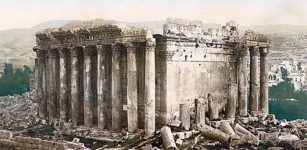Daily Life Of Télpochcalli Students Of The Aztec Empire Was A Challenge
Conny Waters - AncientPages.com - Why the Aztecs migrated to the Mexican Valley can be debated, but once they reached the place it didn’t take long before they became the most powerful Mesoamerican kingdom of all time.
“The Nahuatl word aztecatl means “people from Aztlan”. Aztlan is most likely a mythological region that is regarded to have been the origin not only for the Aztecs but for seven different city states in Mesoamerica, of which the Aztecs are but one example.
Historians have traced possible locations for this city – from islands in the South Pacific to Northwestern Mexico and to the South West of the United States.
Before the Aztecs could become warriors they had to be trained properly. Image source
Most of these take as their basis in apocryphal Aztec sayings, which were recorded by Spanish imperials. Thus, the true location of Aztlan will probably always remain a matter of contention. Interestingly, there is no known meaning of the word Aztlan in Nahuatl. The Aztecs themselves had rejected the word Aztec – preferring to call themselves “Mexica”.
It was the 19th century European archaeologists that began using the word Aztec to differ them from other Mesoamerican cultures.” 1
By the early 16th century, the Aztecs ruled over up to 500 small states, and between 5 to 6 million people. Their empire was huge and prosperous.
The Aztec Empire was undoubtedly strong and powerful, but the success of their famous warriors demanded extremely hard training and discipline.
The Aztec Eagle Warriors and Jaguar Warriors struck fear in their enemy, but before they were allowed to fight, they had to be properly trained.
The Aztecs had a school called Télpochcalli where all sons of lower-class citizens received military train that was mandatory.
Boys went to this school when they were 15 years old and their teachers were skilled Aztec warriors who were slightly older. Attending the Télpochcalli was demanding and not everyone managed to become a future Aztec warrior. The purpose of Télpochcalli was to teach students discipline, bravery, and respect and this was accomplished through hard labor and brutal punishments.
The Aztec Empire wanted to have courageous warriors who could achieve success whenever it was necessary. Not all boys succeeded in the harsh training. Those who were tough and passed the training had the honor to serve the mighty Aztec Empire. Having an elevated status in society gave new opportunities in life. Some could even become teachers one day.
What Was It Like To Be A Télpochcalli Student?
An ordinary day in the life of a Télpochcalli student focused on hard work. Aztec students got up early in the morning. After taking a cold bath and having a very modest meal, they had to clean, farm, repair aqueducts, canals, and other buildings. This was part of their physical training with the purpose of strengthening their sense of civic duty. By working together, they learned to cooperate and experience unity and interconnectedness, which were basic requirements for every future warrior.
Young boys learned martial arts and were instructed how to handle Aztec weapons. Many of these weapons were designed to not only kill but to incapacitate, stun or immobilize the enemy. Sometimes it happened that one of the Télpochcalli teachers was required to participate in a war. If this was the case, the Télpochcalli student followed his teacher and served as his apprentices in battle. This meant the youngster started by carrying weapons and late, if he was ready for it, he could help capture enemy prisoners.
See also:
Aztec Empire: ‘Tlatoani’ – The Ruler With The Ultimate Power In The Land
Slaves In The Aztec Empire Had Much Better Rights Than In Any Other Ancient Society
One can imagine many young boys wanted to participate in a battle as soon as possible, but this was not allowed. To prepare, youngsters had to first test their skills in mock fights. How mock fights were organized varied. Sometimes when religious festivals were organized a future warrior could test his skills and strength fighting an enemy prisoner who had been captured in was. It was also not uncommon to stage battles between Télpochcalli students. The one who won the battle received a prize such as food or gifts.
Aztec warriors as depicted in the Codex Mendoza.
“By the time a boy left school he was a warrior, but he still couldn’t go to war alone. First, he had to find a sponsor, a veteran who could accompany him into his first battle. Parents would use food, drink, and gifts to bribe these veterans to watch over their sons, and so it was usually the richer boys who had greater success in war.
The rules of the Télpochcallis were strict and anyone who broke them or deviated from their training was severely punished. For example. A student caught with alcohol could be beaten or even hanged, and leaving school to live with a prostitute warranted being burnt with a stick. Even the teachers could be punished, with their valuables taken and hair cut if they misbehaved.” 2
Being a Télpochcalli student was a challenge and not everyone could complete these studies, but that how the Aztecs trained their warriors to become successful on the battlefield.
Written by Conny Waters – AncientPages.com Staff Writer
Copyright © AncientPages.com All rights reserved. This material may not be published, broadcast, rewritten or redistributed in whole or part without the express written permission of AncientPages.com
Expand for references- Prince, William Myron. Aztec History: The Incredible History Of One Of The Greatest Ancient Civilizations Of Our World
- All About History Aztecs First Edition, Future Publishing Limited, 2019
More From Ancient Pages
-
 Xochipilli: Aztec God Of Love, Music, Song And Ecstatic Mushroom Trance
Aztec Mythology | May 19, 2018
Xochipilli: Aztec God Of Love, Music, Song And Ecstatic Mushroom Trance
Aztec Mythology | May 19, 2018 -
 Unusual Ancient Spider Pipes Of Tennessee – Were They Used By Shamans To Enter The Spirit World?
Artifacts | Feb 18, 2018
Unusual Ancient Spider Pipes Of Tennessee – Were They Used By Shamans To Enter The Spirit World?
Artifacts | Feb 18, 2018 -
 Diver Says He Found Mysterious Underwater Ancient Tomb, Ruins And Artifacts Of An Unknown Advanced Civilization
Featured Stories | Oct 10, 2023
Diver Says He Found Mysterious Underwater Ancient Tomb, Ruins And Artifacts Of An Unknown Advanced Civilization
Featured Stories | Oct 10, 2023 -
 Archaeologists Have Discovered A Mummy Wrapped In Gold – Here’s What It Tells Us About Ancient Egyptian Beliefs
Featured Stories | Feb 7, 2023
Archaeologists Have Discovered A Mummy Wrapped In Gold – Here’s What It Tells Us About Ancient Egyptian Beliefs
Featured Stories | Feb 7, 2023 -
 Count Dracula: His Letters Helped Researchers Cast New Light On Health Of Legendary Figure
Historical Figures | Aug 17, 2023
Count Dracula: His Letters Helped Researchers Cast New Light On Health Of Legendary Figure
Historical Figures | Aug 17, 2023 -
 Ganesha: Elephant-Headed God Of Knowledge, Learning, Literature And Scribe Of The Mahabharata
Featured Stories | Aug 17, 2016
Ganesha: Elephant-Headed God Of Knowledge, Learning, Literature And Scribe Of The Mahabharata
Featured Stories | Aug 17, 2016 -
 Settlement Of Europe: Result Of Several Migration Waves By A Single Population – Study
Archaeology | Jul 17, 2020
Settlement Of Europe: Result Of Several Migration Waves By A Single Population – Study
Archaeology | Jul 17, 2020 -
 Rare Mammoth Ivory Tool Offers Evidence Of Ropemaking In Central Europe More Than 35,000 Years Ago
Archaeology | Feb 5, 2024
Rare Mammoth Ivory Tool Offers Evidence Of Ropemaking In Central Europe More Than 35,000 Years Ago
Archaeology | Feb 5, 2024 -
 Mystery Of The Tower Of Babel – The Mountain Of God Or A Symbol Of Chaos And Ignorance?
Biblical Mysteries | Oct 14, 2014
Mystery Of The Tower Of Babel – The Mountain Of God Or A Symbol Of Chaos And Ignorance?
Biblical Mysteries | Oct 14, 2014 -
 Mysterious Kallerup’s Double-Headed Figurine – Evidence Of Unknown Norse God Or Worship Of Roman God Janus In Ancient Scandinavia?
Artifacts | Mar 19, 2020
Mysterious Kallerup’s Double-Headed Figurine – Evidence Of Unknown Norse God Or Worship Of Roman God Janus In Ancient Scandinavia?
Artifacts | Mar 19, 2020 -
 Sacred Island Ukonsaari Of The Sami People Will Be Respected – Tourism Company Ends Landings On The Island
News | Nov 14, 2019
Sacred Island Ukonsaari Of The Sami People Will Be Respected – Tourism Company Ends Landings On The Island
News | Nov 14, 2019 -
 Secrets Of Namibia’s Fairy Circles Solved – Self-Organizing Plants Are The Creators – New Theory
Archaeology | Oct 21, 2022
Secrets Of Namibia’s Fairy Circles Solved – Self-Organizing Plants Are The Creators – New Theory
Archaeology | Oct 21, 2022 -
 ‘King Arthur’s Hall’ Is 4,000 Years Older Than Previously Thought
Archaeology | Nov 12, 2024
‘King Arthur’s Hall’ Is 4,000 Years Older Than Previously Thought
Archaeology | Nov 12, 2024 -
 Baalbek: Were The Megaliths Put In Place Under Herod?
Archaeology | May 27, 2019
Baalbek: Were The Megaliths Put In Place Under Herod?
Archaeology | May 27, 2019 -
 Unique Female Viking Grave In Swedish Mountains Reveals Its Secrets
Archaeology | Jul 14, 2023
Unique Female Viking Grave In Swedish Mountains Reveals Its Secrets
Archaeology | Jul 14, 2023 -
 Are These Puzzling Rings Finger Loops From Ancient Weapon Systems?
Archaeology | May 24, 2023
Are These Puzzling Rings Finger Loops From Ancient Weapon Systems?
Archaeology | May 24, 2023 -
 Artifacts From Shakhi Kora Reveal The Rejection Of Early Centralized Governance In Ancient Mesopotamia
Archaeology | Dec 9, 2024
Artifacts From Shakhi Kora Reveal The Rejection Of Early Centralized Governance In Ancient Mesopotamia
Archaeology | Dec 9, 2024 -
 Mysterious Deaths In A Dangerous Valley May Be Related To Ancient Events
Featured Stories | Mar 14, 2022
Mysterious Deaths In A Dangerous Valley May Be Related To Ancient Events
Featured Stories | Mar 14, 2022 -
 Ancient DNA Helps Reveal Social Changes In Africa 50,000 Years Ago That Shaped The Human Story
DNA | Jun 7, 2022
Ancient DNA Helps Reveal Social Changes In Africa 50,000 Years Ago That Shaped The Human Story
DNA | Jun 7, 2022 -
 Mysterious Ancient Maya ‘Star War’ Glyph And Its Possible Connection To Venus
Archaeoastronomy | Feb 20, 2019
Mysterious Ancient Maya ‘Star War’ Glyph And Its Possible Connection To Venus
Archaeoastronomy | Feb 20, 2019


